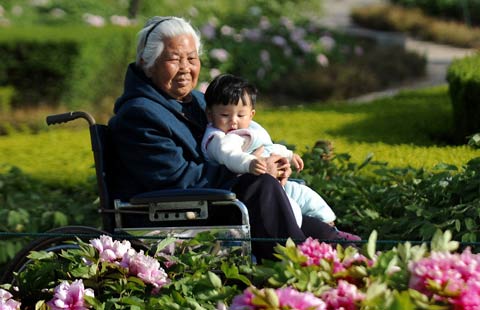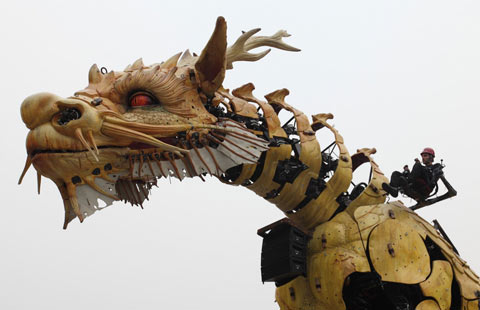Face of change
Updated: 2014-10-28 07:27
By Sun Yuanqing(China Daily)
|
|||||||||||
Chinese architect Ma Yansong's new book, Shanshui City, shows the philosophy behind his designs. Sun Yuanqing reports.
Acclaimed Chinese architect Ma Yansong launched his book Shanshui City at Beijing's Ullens Center for Contemporary Art last month, in an attempt to explain to the world his designs inspired by shan shui, a Chinese art style that is used to paint mountains and water.
In his book, Ma shows how he built on the concept with the help of images of his projects taken by renowned graphic designer Kenya Hara.
In shan shui, artists use brush and ink to portray natural scenery. For Ma, who is known for his futuristic designs, shan shui is not just mountains and water, but rather a modern interpretation of the Eastern spirit of nature.
"It's not about a particular style or shape, or the usage of natural elements. It's an experience of nature. If you feel comfortable with the breeze and the sunshine in the building, it is the feeling of shan shui," says Ma, 39, founder of MAD Architects.
In July, his firm was chosen as the lead designer for Lucas Museum of Narrative Art in Chicago, due to "its innovative approach to design and the philosophy of connecting urban spaces to natural landscapes", making it the first Chinese architecture outfit to design an overseas cultural landmark.
While details of the Lucas design have yet to be released to the public, Ma cites the Chaoyang Park Plaza in Beijing, as a recent major example of the shan shui approach. The project, which was launched in April, will cover more than 120,000 square meters of commercial and residential buildings in Beijing's central business district, located south of one of the city's largest parks.
Ma has designed towers of the buildings to resemble ridges and valleys that allow free flow of air. The project was given the "Leadership in Energy and Environmental Design" certification by US Green Building Council for the use of environmentally friendly technology.
But shan shui is not the same as the Western concept of "green" infrastructure, Ma says. "The green building is a technical concept. Shan shui is about the atmosphere between people and nature. It's spiritual. It's about the way you feel when you enter a building, if you feel comfortable or touched," Ma adds.
To create that feeling, the buildings are integrated with landscape elements. The two main towers are connected with a courtyard lobby. The sound of flowing water in the lobby adds to the feeling of a valley amid mountains. Terraces and courtyards on different floors are arranged to allow people to wander freely.
Ma, who grew up in the hutong (narrow lanes), has witnessed Beijing change over the past few decades through urban development. Architecture in modern Chinese cities has become about competition for wealth and power, without concerns for people or the environment, he says. "If the last 30 years were about accumulation, now is the time for redemption."
"China is in a dilemma, in which one way is to get totally Westernized. People believe what they see, so they would say, 'Let's build cities like Hong Kong, Tokyo or New York.' Others would say we should go back to the older times, but they can't answer how the city will accommodate so many people," Ma says.
Futuristic cities should "pay attention to people, nature and the connection between the two", he adds.
Ma studied at Beijing Institute of Civil Engineering and Architecture before acquiring a master's degree in architecture from Yale University, where he was mentored by Iraqi-British architect Zaha Hadid. He founded MAD Architects in Beijing in 2004.
He first received global attention in 2002, when he proposed rebuilding designs for New York's World Trade Center in the aftermath of 9/11. Ma's proposal included creating a midair metropolis to marry urban lifestyle and work environment.
The Absolute Towers in Mississauga, Canada, marked Ma's first major international success in 2006. The twin residential buildings, also known as Marilyn Monroe for their curvy shapes, twist skyward to maximize the connection between residents and the surrounding natural scenery. The project was named the Best Tall Building in the Americas by the Chicago-based Council on Tall Buildings and Urban Habitat in 2012.
Although the debate in China's architecture world is ongoing, Ma has become an idol for the country's many young architects, says Fang Zhenning, a critic and curator.
"He is, after all, the first architect who grew up in China to win an international project, and that is the dream for many young architects."
When asked about his vision of Beijing in 2050, Ma says, "people will feel like they are in gardens. All high-speed traffic should be underground".
"The direction of history is there, and things will happen faster than you imagine," he adds.
Contact the writer at sunyuanqing@chinadaily.com.cn
(China Daily 10/28/2014 page20)
Today's Top News
Poroshenko's bloc leads parliamentary election
Occupy Central 'hatched 2 years ago'
Ukraine's early parliamentary election kicks off
Envoy champions UK China relations
Highlights of Shenzhen Int’l Photography Week
Palace Museum needs to design landmark souvenirs
In Guangdong, 42 hours of fear
Ambassador urges young people to build up ties
Hot Topics
Lunar probe , China growth forecasts, Emission rules get tougher, China seen through 'colored lens', International board,
Editor's Picks

|

|

|

|

|

|





